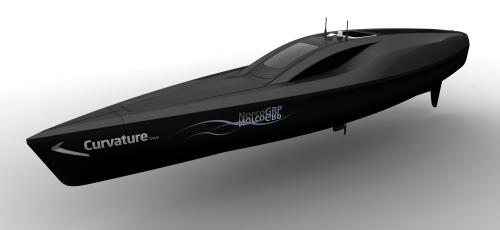
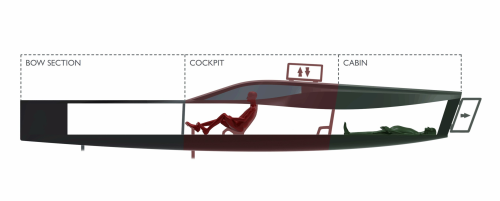
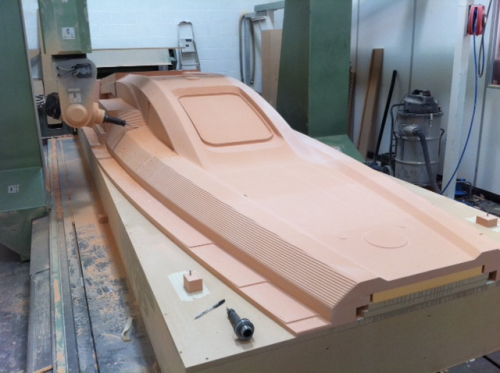
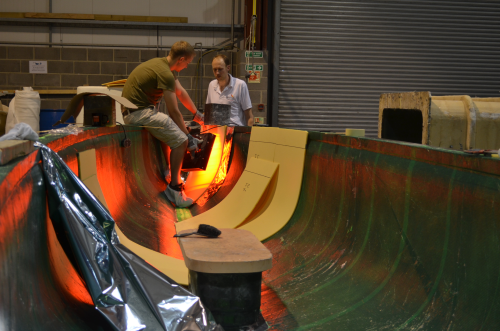
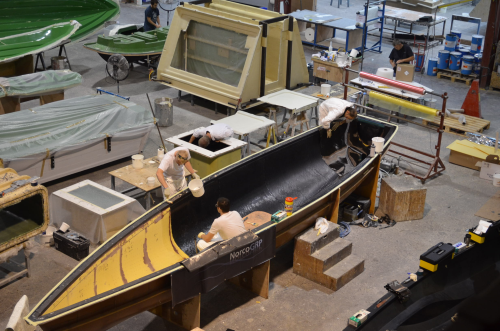
Most people don’t believe me when I tell them that no beer was involved in the creation of Project Torpedalo. The idea to design, build and use an ocean-crossing carbon fibre pedal-boat, from scratch, to raise money for charity was one that grew from an amalgamation of several concepts between my friend and colleague Mark Byass and I in September 2009 – not , as most people expect, from an over-ambitious session in The Dog & Duck.
Project Torpedalo is certainly a charity project like no other. We’ve designed what we hope to be a safe, reliable and fast pedal-powered boat, and within the next twelve months we’re going to attempt to pedal it 3000 miles across the Atlantic Ocean. The goals are simple: raise as much money as possible for the Motor Neurone Disease Association and Make-A-Wish Foundation UK, and set a new world record.
There are two options for the crossing – the first is Canary Isles to Barbados in December this year, and the second is New York to the Scilly Isles in June 2012. With the boat now in build, we’re already in a race against time to make sure we have enough time to test the finished boat before we attempt the Atlantic.
Getting to this point has been difficult, stressful and rewarding in roughly equal measure – this is the story so far.
Boat design
From the inception of the project, we knew what the two most difficult aspects would be. First would be fitting the work to design the boat and run the project around our day jobs as automotive engineers. Secondly, as the ultimate goal was to raise money for charity, we didn’t want to have or use any budget – so we set ourselves the ridiculous ambition to design, test, build and equip our boat for a net cost of £0.
Mark led the design of the Torpedalo, starting by forming a team of marine industry experts who each had their own area of expertise – everything from fundamental hydrodynamics to the properties of carbon fibre.
Mark then started several streams of work that he eventually drew together to form the exterior surfaces of the boat, including testing various hull shapes in Newcastle University’s MAST towing tank facility, using CFD to optimise the aerodynamic profile of the upper surfaces, and weighing and measuring everything we’d need onboard (including scanning ourselves in 3D) to form a digital packaging model.
We were fortunate from the outset to have the support of Autodesk, who provided all of the CAD and surfacing software we’d need to design the boat. Concept Group International in Coventry were also one of our first sponsors, machining the boat models for tank testing, and continuing to provide machining support now.
After optimising the exterior surfaces of the boat, Mark set about engineering the interior compartments to make the boat as useable and safe as possible. The result is this: a boat that is 40% more hydrodynamically efficient than the equivalent rowing boats but with an identical level of tailwind assistance, a low-drag and stable headwind profile, three separate watertight compartments with two sealed areas of reserve buoyancy, and the inherent ability to self-right if capsized.
While Mark worked on the boat design, our friend and engineering hero Paul Fish set to work designing the drive system. The final design is a two-stage belt driven system, utilising a Rohloff fourteen-speed internal gear hub together with toughened belts from Gates Corporation and a custom propeller from specialist firm Bruntons. The drive system has efficiency above 80%, and is lightweight, easy to service and reliable.
Boat construction
We knew that the biggest hurdle to achieving our goal of zero spend would be the construction of the boat. The project had already secured some fantastic partners for the supply of the equipment we’d need, from the electronic systems through to boat fittings and the food we’ll eat. However, the build would demand involvement of a value that could only be measured in tens of thousands of pounds – a different league entirely. We started by trying to agree deals with suppliers for materials and mould tools, and in this case it appears that fortune favoured the cheeky.
We were ecstatic to first secure John Burn Ltd as our supplier for tooling board with which to make the boat mould tools. John Burn had already donated SikaBlock polyurethane foam to make the hull test models, and they went on to provide all of the tooling block for every boat mould tool. One of their suppliers, German company Sika, then came onboard to supply layup resins. Hexcel commited to supply carbon fibre, SP (Gurit) sent core foam, and James Latham plc sent MDF to form the bases of the largest patterns.
Then came the first major deal – Curvature Group in Tring and sister company MonsterCAM in Lee-On-The-Solent agreed to machine the two eight-metre long male patterns for the boat. This was a huge amount of work, but MD Nick Phelps couldn’t resist getting involved, and delivered two precision cut patterns from which we could then take female moulds.
So, we had materials and patterns – now we had to find the biggest single operational sponsor of the whole project: Someone to build the boat. After nine months of research and sponsorship approaches, and after having almost lost hope of fnding a boat builder, we went to The Composites Engineering Show at the NEC. There, we started a conversation with Mark Northey, MD of Norco GRP in Poole – an informal chat that would prove to be the start of an incredible partnership! Within a month of meeting Mark, he agreed to do all of the boat construction work – making the female moulds, laying up the individual section, bulkheads and floors, bonding them all together and painting the finished structure.
Curvature Group and MonsterCAM completed the machining of the patterns in SikaBlock M440 foam at the end of June. On receipt of the mould tools at Norco, the team there set about making the fibreglass female moulds, plants for the windows and alignment tools for mounted components like the rudder stock. Simultaneously, they started making bulkheads and small parts via resin infusion.
Both female moulds were demoulded at the end of July, and lay-up of the main hull of the boat itself started immediately.
Once finished and cured, a 10 mm layer of CoreCell foam from SP Gurit was shaped and bonded in place using paste from John Burn. The inner skin was then laid up, completing the sandwich construction of the hull. Several different specs of Hexcel carbon fibre have been used, including ±45° 200 g/m2 and 400 g/m2 fabric for the majority of the construction, with 300 g/m2 unidirectional tape and 470 g/m2 plain weave fabric for reinforced or high-stress areas. While the completed carbon shell of the boat will only weigh 175 kg, the predicted weight of the Torpedalo at the start of the ocean crossing will be 1.2 tonnes when loaded with 300 kg of food, two 100 kg men and a huge amount of equipment.
The challenge
The team at Norco are doing an incredible job so far, and we have no doubt that the finished boat will have been built to the highest standard. It’ll need to be – the challenge facing it and us is extreme.
Mark and I will take turns pedalling in two hour shifts, from the start to the finish. We’ll have to navigate around harsh weather and rough seas, avoid commercial shipping traffic and deal with the very real threat posed by sharks.
We’ll have to eat 7500 calories a day (three times the average adult male daily intake), drink 12 litres of water every 24 hours, and medicate our bodies to stop them falling apart.
Strangely, we’ll also be naked the entire time – while potentially slightly awkward (and presenting an interesting challenge to filming the crossing), it’s the best way of avoiding skin sores and rashes from prolonged exposure to saltwater.
The finished shell of the boat will make its first public appearance at the Southampton Boat Show in September, before being shown at TCT Live and Cycle Show, both at the NEC at the end of September.
We’ll then bring her back to Torpedalo HQ in Crewe for fitting out with the electrical system, hatches, drive assembly and steering system so that on-water trials can be being as soon as possible. These will start with basic low-speed test on calm water and a capsize drill to make sure the boat self-rights.
We’ll then pedal her in increasingly more challenging water – from Lake Windemere and Loch Ness to the Irish Sea. All being well, we’ll then make final preparations for the ocean adventure, load the boat with all of our supplies, pack it in to a shipping container and send it to the start line! ♦
More information, latest news, photos and video can all be found at www.torpedalo.com, where you can also make a secure online donation to our charities. You can also follow the project on Facebook and Twitter by searching for Torpedalo.






